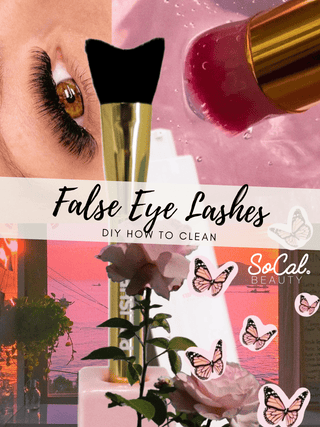DIY How to Clean False Eyelashes
False eyelashes look fantastic on a big night out. They don’t smudge as easily as mascara does, and they can be easier to take off, too. However, just because they don’t need to be taken off with makeup remover and treated along with the rest of your skincare regimen doesn’t mean that you can just put them away in a box and not get them out again until your next big night out. Here is a guide on how to clean false eyelashes.
Why Clean False Eyelashes?
Good false eyelashes can be an expensive purchase. If they are cheap and disposable, they probably don’t look very good when you are wearing them. After all, you do get what you pay for. Cost is a big reason you need to take care of your false eyelashes.
If you buy a decent pair of false eyelashes, they should be quite easy to clean with a product such as this Rose Water Lash Cleanser, and you can use them multiple times. There is no reason to throw good money away if you don’t have to. Take care of your false eyelashes and you can wear them repeatedly, which will give you more money to spend on drinks.

How To Remove False Eyelashes
Before you can clean them, you need to remove them. This needs to be done with your fingertips rather than your nails or a pair of tweezers. It may make you feel a bit squeamish to put your fingers to your eyes, but if you do the job by hand, you will keep your eyelashes in better shape and will be able to reuse them more easily.
Wash your hands before beginning so you don’t run the risk of putting bacteria in your eye. Grip the corner of your false eyelashes between your thumb and your forefinger and gently peel off the eyelash. You should then clean up any residual glue from your eyelashes or eyelid with makeup remover and a pad or tissue. Don’t be tempted to clean glue with your fingers as this could cause you to lose some of your own eyelashes, too.
How To Clean Synthetic Eyelashes

If you have put mascara on your false eyelashes, you will need to use an oil-free makeup remover to take it off. Failure to do so will cause your false eyelashes to go out of shape, and it could make you prone to getting an eye infection next time you wear them.
Start by placing your false eyelashes on a clean towel and gently wiping them with an eye pad or tissue and some oil-free makeup remover. Pay attention to the lash bands as these are more likely to clog up with glue.
Wipe your false eyelashes again with a tissue or eye pad that has been soaked in water to remove the makeup remover and gently peel off any excess glue.
Once you have washed them, arrange them back into their original shape and leave them on the towel until they are dry. You can then put them back in their box and store them safely until their next use.
How To Clean Natural Fiber Lashes
Natural fiber lashes, such as mink, need to be cleaned differently from synthetic lashes as using water and cleaning products on them will make them lose their shape.
Once you have removed them, you should take off the excess glue using a pair of tweezers. Never be tempted to soak them in water.
General Tips

Regardless of what type of lashes you have, you should always throw them away if you are unable to get all the glue off. Re-wearing false eyelashes that aren’t clean could give you an eye infection that won’t give you the look you were aiming for.
Although it is safe to re-wear false eyelashes, you should only wear them a couple of times before you throw them away for hygiene reasons.
Reusing false eyelashes should be for personal application only. You should never take them to a makeup counter for reapplication or ask a friend to do it for you. Regardless of how clean their hands are, you are more likely to get an eye infection if someone else applies them.
Follow these tips for cleaning your false eyelashes and you should be able to reuse them a couple of times with no issues. However, if in doubt, it is always safer to invest in a new pair than risk getting an infection.

